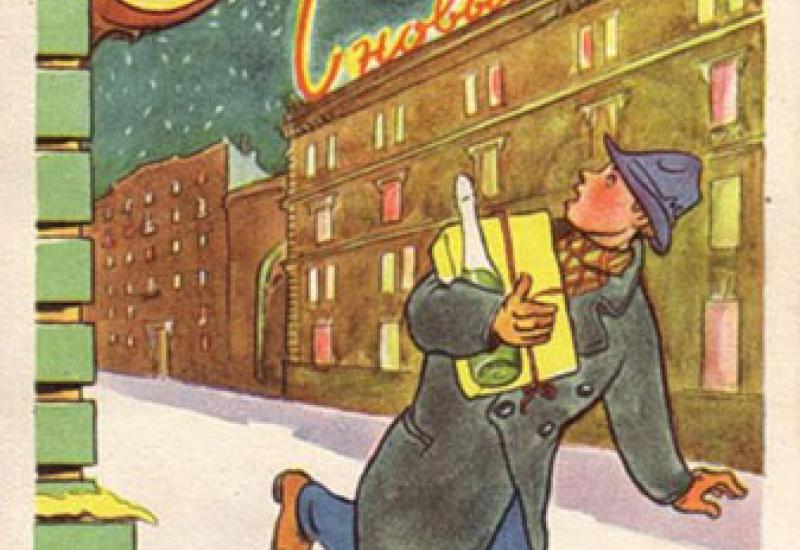In the XV century the New Year in Russia has been met on March 1 on the Julian calendar, and later - September 1 (summarizing harvest). Only in 1700, Peter 1st, following the example of Europeans issued a decree about celebrating New Year on January 1st.
In 1918 the country switched to the Gregorian calendar, which shifted all the dates 13 days back. In memory this event stayed as the "Old New Year", which even those who do not know about the change of the calendar like to celebrate. After the revolution, in 1929, the Christmas tree was canceled as a religious holiday. It returned in 1937 by the decision of the party and government "On New Year celebration in the USSR." In the Hall of Columns there was the first official USSR fir-tree with a red star on the top instead of Christmas.
New Year has been completely rehabilitated, and in different decades was celebrated as follows:
Thirties
Greeting: December 31, 1935 Chairman of the CEC of the USSR Mikhail Kalinin congratulated polar explorers who were drifting in the ice. It was used the long waves communication. It was the first in the country radio greeting. Later it will become an annual event.
Music / dance: in the cities there were popular tango performed by orchestras Leonid Utesov and Alexander Tsfasman, recording Vadim Kozin "Parting" ("Burnt by the Sun"), romances "gate" and "Misty Morning". And in the villages - folk songs.
Fourties
Greeting: December 31, 1941 Mikhail Kalinin spoke on the radio and told about the results of the first year of the war. Radio greetings were broadcasted up to 1944. Then they was canceled until 1953.
Music/ dance: waltzes and fox-trots - the songs of Claudia Shulzhenko, Ivan Shmelev ("For the factory Gate"), Vladimir Nechaev ("We are the people of a large flight"), George Vinogradov ("My Happiness" and "love"
Fifies
Greeting: December 31, 1953 the Chairman of the USSR Supreme Kliment Voroshilov greeted the Soviet people on the radio.
Listen to / dance: Popular Artists Vladimir Bunchikov ("Flying migratory birds"), Capitolina Lazorenko ("Besame Mucho") and Ruzhena Sikora ("Lights"). Waltz, charleston, shimmy, lindy pop. In the early 50-ies in the USSR began to be sold sound cards: on the one hand was glued with shellac little verse of a popular song, and the other - text and photo of the singer, and centerfold printed notes.
Food on the table: in 1952 it was the first edition of "The Book of Tasty and Healthy Food" (project personally supervised the people's commissar of food industry, Anastas Mikoyan). The epigraph to it were the words of Stalin: "The revolution gave people not only freedom, but also wealth, as well as the possibility of a prosperous and cultured life." To create a book it was needed 16 years. It included recipes peoples of the USSR, their collection must strengthen the friendship between the republics. Therefore, in addition to the popular aspic, in a festive menu might appear, for example, rice.
Sixties
Greetings from the middle of the fifties and until 1970 was impersonal - from the CPSU Central Committee, the Supreme Soviet and the USSR Council of Ministers.
Listen to / dance: they began to come into vogue electric musical instruments. People loved Helena Velikanova ("I have fun"), Georg Ots ("When you go on a date"), Maya Kristalinskaya ("The Moonstone"), Valery Obodzinskii ("These eyes opposite"). The dances were unchanged waltzes, fox-trots, Charleston.
Food. In the beginning of the sixties the obligatory attribute of the New Year table was a "Soviet champagne". Though it started mass production in 1939, but it was expensive. And in 1961, the process is automated, and champagne fell by 20%.
Seventies
Greeting: December 31, 1970 to 10 minutes to midnight Leonid Brezhnev himself greeted the Soviet people- it was the first greeting of the head of state. Leonid Ilyich read text on a piece of paper, not looking at the camera. Therefore, next year it was written in large letters on a sheet of paper in front of him. The director "Ostankino", sitting under the camera, held this sheet.
After 1976 due to poor health Brezhnev (then - Andropov and Chernenko) a popular TV speaker Igor Kirillov several times welcomed the country.
Listen to / dance: a host of vocal and instrumental ensembles (VIA) "Pesnyary," "Ariel" Uzbek "Yalla" Azeri "Gunes", "Gems", "Flowers", "Flame". On the seventies it was the peak of popularity Muslim Magomayev.
Food: there were salads contained layers - herring under beetroot and "Mimosa". The main decoration of the table was considered baked chicken (or fried chicken), and delicacy - sandwiches with sprats.
Eighties
Greeting: in December 1985 Mikhail Gorbachev congratuled the country. Shooting took place in his office, which he did not allow decorate even with fir branches. However, in December 1986 Mikhail Gorbachev came up with the avant-garde move - he congratulated the Americans a Happy New Year, and the Soviet people was congratulated by US President Ronald Reagan.
Listen to / dance: the era of disco, women of all physique dancing the lambada. Listen to songs Leontiev, Veske, Jaak Jolla, "Earthlings" and "Tender May", as well as western VIA - ABBA, Boney M, Modern Talking.
Nineties
Greeting: December 31, 1991, Gorbachev resigned, the country was congratulated by satirist Mikhail Zadornov. But failed to meet the timing, because of what had to be delayed broadcast of the fight chimes on a minute. Russian President Boris Yeltsin made his first greeting to a year. Ukraine on New 1992was firstly congratulated by President Leonid Kravchuk, elected December 1, 1991
Listen to / dance: songs Yevgeny Belousov, Vladimir Markin, Korneliuk Igor, Sergei Minaev, groups of "Mirage" and "Carmen".
Food: it were appeared overseas products: alcohol Royal, Vodka Black Death, «Bush legs" and the first "Snickers" and "Mars."
And what happens in the celebration of the two thousandth, each of us remembers and can share your memories in a pleasant company.

